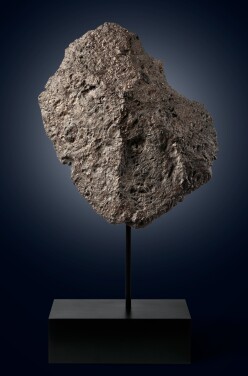F or most of us, the opportunity to explore outer space first-hand is simply out of our orbits. Fortunately, for those thirsting for more space, there are meteorites: extraterrestrial rocks primarily from the asteroid belt along with rare samples from the Moon and Mars.
Meteorites are not the same as meteors — the zippers of light in a night sky we make wishes upon — which burn up in the atmosphere. Meteorites originate from fireballs that appear just how the term sounds; the arrival of a meteorite is a memorable phenomenon most often accompanied by sonic booms and at times destructive pressure waves.
Meteorites are extraordinarily rare. The total weight of every single known meteorite is less than the world’s annual output of gold. And specimens of the Moon and Mars are among the greatest of rarities on our planet — as every bit of both would fit in the cargo hold of a large SUV. Specimens of these planetary bodies arrive on Earth as meteorites as a result of asteroid impacts having blasted lunar and Martian surface material into space — some of which entered Earth-crossing orbits.
Most meteorites are older than our home planet and not only provide a record of the birth of the solar system but possibly the genesis of life, as many meteorites contain amino acids and tens of thousands of other organic compounds. Select meteorites contain the oldest matter mankind can touch. More than a thousand cosmochemists throughout the world devote their lives to the study of meteorites — which have also become an increasingly hot collectible given an ever-increasing demand and limited supply.
While you may wish to have a single aesthetic meteorite in your home or office, or desire to build a collection, where do you start? We’ve assembled a guide to assist you; whether your interest is in slices which reveal the interior of a meteorite or complete specimens, be prepared to be enthralled.
Types of Meteorites
First, there are three types of meteorites: stones, irons and stony-irons — and here’s why. In early solar system history repeated collisions between asteroids occurred; it was a cosmic pinball gallery. Many of these collisions were catastrophic resulting in the total shattering of many asteroids — and thus the source of the vast majority of future meteorites.
Stony meteorites
Stony meteorites represent the crust and mantle of these former protoplanets, as this is the majority of an asteroid’s volume that’s why nearly 95% of all meteorites are stony. Some even contain impact melt breccias of different rocks. There are two types of stony meteorites: chondrites, which are those that have not experienced undue heat and pressure and possess chondrules (spherules that condensed out of the gaseous solar nebula from which our solar system was born), and achondrites, those without chondrules, which are far less common.
Iron meteorites
Iron meteorites originate from the small molten cores of these asteroids which explains why iron meteorites are far more rare. For iron meteorites to exist, the parent bodies from where they originate are from shattered apart and no longer exist — and most have crystallized, which is a feature that is diagnostic in the identification of an iron meteorite.
Stony-iron meteorites
More rare still are the stony-irons, the combination of the other two classes. The pallasite variety of stony irons — which contain semi-precious gems from space and are the most beautiful extraterrestrial substance known — originate from the narrow boundary zone between the mantle and core of asteroids, and this is why they represent less than 0.2% of all meteorites. Superlative examples of all three of these types — as complete specimens, slices and spheres — in addition to samples of the Moon and Mars are represented in the upcoming sale.
The Basics of Determining Value
The commercial value of meteorites can range from a few dollars to a few million depending on a number of factors. Everything else being the same, here are a few of the determinants of a meteorite’s value:
Weight
The less total mass available in the private sector, the more valuable. The more the specimen weighs, the more valuable.
Number of different specimens
The fewer specimens from a specific event or classification the more valuable.
Scientific classification & scientific interest
Rare classes or those meteorites that pique the curiosity of researchers are worth more;
Fall vs. Find
If someone witnessed the fireball shoot through the sky from which meteorites were recovered it is referred to as a “fall,” which are more valuable than meteorites stumbled upon long after they landed and can’t be ascribed to a witnessed event.
Meteorites with a known return address
We do not precisely know the parent bodies from which the vast majority of meteorites originate but samples of the Moon, Mars and Vesta are worth more.
Locality of recovery
Meteorites recovered from unusual localities are worth more.
Presence of fusion crust
Meteorites experience frictional heating as they plunge through the atmosphere, as a result, they acquire fusion crust, which is not present on all meteorites as a result of it having weathered away or breaking off on impact. Those with fresh fusion crust are worth more.
Semi-precious gems from space
The presence of peridot and the quality of the crystals is a determinant of value.
Complete specimens vs. Slices
Everything else being the same, slices of rare meteorites are more valuable per unit weight than a complete mass which weighs the same.
Meteorite sculpture
If the meteorite has been fashioned into a sphere or is otherwise machined, it is worth more.
Provenance & historic meteorites
Meteorites with compelling terrestrial stories are worth more. If a meteorite was deaccessioned from a museum or originates from a famous private collection it’s worth more.
Aesthetics
This was not always the case, but today the more aesthetic the specimen the more valuable — and most meteorites are not aesthetic — and the beautiful meteorites in this offering provide a skewed perspective in this regard!










